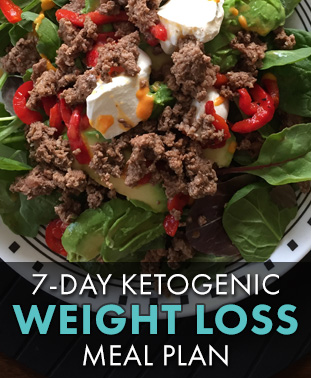A Day in Food on the Ketone Diet
Total: 2,800 calories, 80 percent from fat, about 12 from protein, and 8 from carbohydrates.
Sweeney eats eggs for breakfast every day, but he changes his protein sources for lunch and dinner, swapping in chicken, duck, and occasionally lamb.
Do keto in phases. For six to eight weeks before an event, Sweeney is strict, measuring his ketone levels three times a week and keeping his carbohydrate intake below 50 grams per day. During the off-season, he’s more laid-back. After a strict phase of keto, he says, “you’re adapted, and it takes almost as long for your body to go back to burning glucose as fuel.”
Sweeney drinks about a gallon of water a day, much of it lime-flavored Poland Spring sparkling water. “Most people on the keto diet don’t get enough water,” he says. “When you’re ketogenic, especially if you’re eating a lot of cheese, water is super important to keep your digestive tract cleaned out.”
How the Sugar Industry Shifted Blame to Fat
The sugar industry paid scientists in the 1960s to play down the link between sugar and heart disease and promote saturated fat as the culprit instead, newly released historical documents show.
The internal sugar industry documents, recently discovered by a researcher at the University of California, San Francisco, and published Monday in JAMA Internal Medicine, suggest that five decades of research into the role of nutrition and heart disease, including many of today’s dietary recommendations, may have been largely shaped by the sugar industry.
Even though the influence-peddling revealed in the documents dates back nearly 50 years, more recent reports show that the food industry has continued to influence nutrition science.
Last year, an article in The New York Times revealed that Coca-Cola, the world’s largest producer of sugary beverages, had provided millions of dollars in funding to researchers who sought to play down the link between sugary drinks and obesity. In June, The Associated Press reported that candy makers were funding studies that claimed that children who eat candy tend to weigh less than those who do not.
The revelations are important because the debate about the relative harms of sugar and saturated fat continues today, Dr. Glantz said. For many decades, health officials encouraged Americans to reduce their fat intake, which led many people to consume low-fat, high-sugar foods that some experts now blame for fueling the obesity crisis.
Diabetes and Your Diet: The Low-Carb Debate
A few years ago, Richard Kahn, the now-retired chief scientific and medical officer of the American Diabetes Association, was charged with organizing a committee to prescribe a diet plan for people with diabetes. He began by looking at the evidence for different diets, asking which, if any, best controlled diabetes.
“When you look at the literature, whoa is it weak. It is so weak,” Dr. Kahn said in a recent interview.
Studies tended to be short term, diets unsustainable, differences among them clinically insignificant. The only thing that really seemed to help people with diabetes was weight loss — and for weight loss, there is no magic diet.
“If the goal is to get patients off their medications, including insulin, and resolve rather than just control their diabetes, significant carb restriction is by far the best nutrition plan,” said Dr. Sarah Hallberg, an osteopath at a weight loss clinic in Indiana. “This would include elimination of grains, potatoes and sugars and all processed foods. There is a significant and ever growing body of literature that supports this method.”
But there are no large and rigorous studies showing that low-carbohydrate diets offer an advantage, and, in fact, there is not even a consensus on the definition of a low-carbohydrate diet — it can vary from doctor to doctor.
Even if diets are effective in the short term, Dr. Hall said, “the difficulty is adhering to the diet over the long term.”
In an analysis of weight loss diets (not specifically for diabetics) published this summer, he and Yoni Freedhoff of the University of Ottawa wrote: “Diet adherence is so challenging that it is poor even in short-term studies where all food is provided. When diets are prescribed, adherence is likely to diminish over the long term despite self-reports to the contrary.”
“In the short term, the low-carbohydrate diet sometimes does better on glycemic control,” he said. “But as time progresses, the difference mostly disappears. What counts is which diet helps most with long-term weight loss. “
The reason the advantage sometimes seen with a low-carbohydrate diet tends to vanish, Dr. C. Ronald Kahn added, is probably a mix of people failing to adhere to the diets and their bodies’ adjusting to them.
The 5 Most Crucial Carbohydrate Questions Answered
It’s not so much “good” or “bad”: A better way to label carbs would be processed and unprocessed (or minimally processed). The latter choices include whole grains, starchy veggies, fruits, and beans. These are high in fiber and more slowly digested, and since they’re minimally processed, they also contain the most nutrients and antioxidants.
Highly processed carbs, like white bread and baked goods, contain little fiber and typically fewer nutrients. These are quickly digested and raise blood sugar fast, which is ideal when you need a quick boost during long rides or runs—but can send you crashing afterwards.
“Carbs stimulate your body’s insulin response,” she says, and “if they aren’t high in fiber, or eaten with foods that contain protein and/or fat, the blood sugar increase and decrease tends to be sharp, which can stimulate hunger. Eating a lot of carbs can make you feel less satisfied and more inclined to graze.”
Going low-carb is not the path to getting lean, says Jarosh, although she acknowledges the initial benefits. “When you cut carbs, you often cut calories, and that can help with weight loss,” she says. Cutting carbs also pulls water out of the cells, which can help you shed even more pounds. Yet “when you re-introduce carbs, that weight will often come back immediately,” says Jarosh. The key is to eat the right amount of carbs, especially if you’re engaging in a high-output activity like cycling.
Jarosh suggests beginning with a combo of 50 to 60 percent carbohydrate, 15 to 20 percent protein, and 25 to 30 percent fat, and adjusting as needed.
Recent studies have suggested that burning fat instead of carbs will improve performance, because the body’s fat reserve is much larger than its glycogen stores (an approach known as ketosis). Yet a 2015 study in the Journal of Applied Physiology found the opposite effect—muscles rely more on carbs as their fuel source during prolonged exercise. In fact, the researchers found carbs contribute to up to 91 percent of energy used by runners. Fat might make great fuel if you’re willing to commit to switching your body into ketosis, but for the average athlete, carbs are the most convenient way to go.
Carb-loading does not mean calorie loading. “The carbs should replace other nutrients, mainly fat, otherwise it can result in weight gain that can be felt on race day,” says Jarosh. In general, a carb-loading diet would be 70 percent carbs, 15 percent protein, and 15 percent fat. You’ll also want to avoid heavy carb-loading the day or night before your event, as this can lead to gastrointestinal distress.
The Art of Eating Carbs Without Putting on Weight
Actually, it’s pretty silly to deprive yourself of this important food group. For starters, they’re one of only three macronutrients (the others being protein and fat), which means cutting carbs out throws your whole balanced diet out of whack. And your body needs them to, you know, function.
“Ninety percent of the brain’s fuel is glucose, so we need carbs in order to not only think straight, but to perform,” Jim White, registered dietician and owner of Jim White Fitness & Nutrition Studios, says. “Also, carbohydrates give us energy. They provide glucose and we [burn] glycogen, which is our tank for fuel in the body.”
After a tough workout is an ideal time to get in the majority of your carbs for the day, White says, especially if you are nervous about eating them.
By dinnertime, he usually urges people to stick to a small serving — unless you’re really craving something starchy. “I see a lot of people skip out on their carbohydrates for dinner, and they’re starving and they end up going and binging on a bunch of stuff they shouldn’t,”
At the end of the day, it’s all about calories. So if you’re planning on indulging in something particularly carb-heavy, White recommends trimming them from the rest of your macros or calories for the day.
FREE 7-Day Keto Meal Plan!
Start the keto diet with your first week planned, including a shopping list and all nutrition information.


